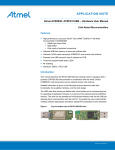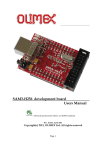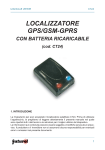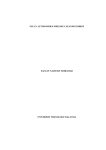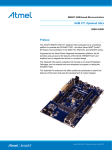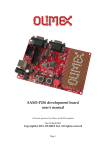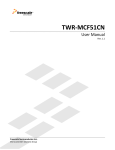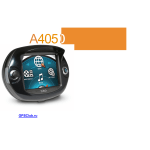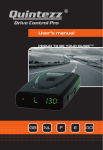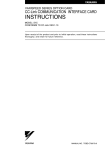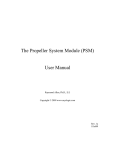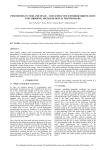Download EM406 GPS-UAV Development Platform Version 2.9
Transcript
EM406 GPS-UAV Development Platform Version 2.9 Hardware description Hardware 05/25/2009 EM406 GPS-UAV Development Platform Version 2.9 The red UAV DevBoard version 2.9 is the replacement for Bill Premerlani’s green UAV DevBoard, which is no longer available. When Analog Devices discontinued the ADXRS401 gyros, Bill and SparkFun decided to revise his UAV development board to use the LISY300AL gyroscopes instead of the ADXRS401. The new “red” board has the following advantages over the previous “green” one: • The LISY300AL has 4 times the dynamic range of the ADXRS401, so the new “red” board is capable of 4 times faster turning rate without saturating the gyros. • The design of the new “red” board has the accelerometers, the gyros, and the A/D reference voltage all operating ratiometrically and tied to a single regulated 3.3 volt power supply. This completely eliminates variations in the 5 volt supply to the board as a source of accelerometer and gyro drift. Bill has revised all of his testing, demo, and flight firmware, available at http://www.diydrones.com/page/uav-devboard, to be able to work with either the previous “green” board or the new “red” one. Each firmware zip file contains two projects, a green one for the previous board, and a red one for the new board. Hardware Also refer to the schematic, available at SparkFun, to see how the hardware is connected to the CPU. EM406 SiRF III GPS receiver The heart of the GPS-UAV is the GPS receiver. The EM406 SiRF III is more than adequate for determining location and direction of motion. Complete specifications are available either on the manufacturer’s website or at Spark Fun. The EM406 initializes very quickly, so it does not have provision for a backup battery. It does have an internal “supercap” that will save settings for several days. After that the EM406 reverts to factory settings, including 4,800 baud, NMEA, for the communications protocol. Once per second the GPS reports information useful for navigation including longitude, latitude, altitude, and direction and speed over ground. Vertical speed is available via the binary interface. The direction and speed information from the GPS is much more accurate than what you could compute by subtracting successive pairs of positions, since it is based on a Doppler shift calculation using the baseband signal. The location information is generally more accurate than advertised by the manufacturer. Furthermore, if you use the GPS-UAV to simply fly around your flying field, you can improve the accuracy somewhat by navigating in terms of motion relative to a GPS measured reference point, such as the location of your plane when you turn it on. EM406 UAV v2.9 5/25/09 2 Hardware 5/25/2009 Communications with the GPS is either with a NMEA standard format or a binary format. There are two USARTs in the dsPIC30F4011. The communications link between the GPS receiver and the CPU is via TX and RX pins of USART number 2. The board includes a MOSFET transistor to shift the 2.8 volt output of the EM406 up to the 5 volts needed by the input of the CPU. Pin assignments on the CPU are: From GPS to CPU RX2/RF4 From CPU to GPS TX2/RF5 The default baud rate of the EM406 is 4,800 and the default protocol is NMEA, which is quite readable. It is suggested that you purchase Spark Fun’s ET-312 evaluation board or something similar to become familiar with the SiRF binary and NMEA protocols. The GPS LED will flash when the GPS is ready. However: Be careful in setting the reporting rates of the various output messages. In some of the past versions of the SiRFIII, the flashing of the GPS LED was controlled by toggling the LED each time a certain message goes out. If you suppress that message, the GPS status LED may stop flashing. Also, the GPS status LED will stop flashing in the binary communications protocol. Also, do not use the binary protocol at 4,800 baud, it results in a 10 second latency, apparently because of a flaw in the buffer flushing logic. If you are using the binary protocol, use 19,200 baud or higher. Information about the EM406 is available on the Spark Fun website, www.sparkfun.com, or on the manufacturer’s website, www.usglobalsat.com. Antenna The antenna is built into the EM406. Proper operation of the GPS depends only broadly on the orientation of the antenna. For best results, orient the plane of the antenna parallel to the ground. Other than that, the GPS does not require any particular orientation of the antenna. As the antenna moves through space the GPS indicates where it is and its vector velocity. dsPIC30F4011 The CPU is a Microchip dsPIC30F4011. Manuals are available from Microchip at www.microchip.com. The dsPIC30F4011is ideally suited for use in a three axis GPS-UAV, with plenty of processing power and features, including: • 16 bit architecture, with 40 bit accumulators. • C compiler available from Microchip. (There is both a free compiler and a purchased compiler. The optimization features that are included with the purchased compiler become disabled in the free compiler after a month, but they are really not needed for adequate performance of the controller.) There is a great deal of support for the dsPIC30F4011 built into the compiler, including an extensive runtime library. Especially impressive is the smooth and efficient way the vector and matrix routines in the library map onto the hardware. • Clock speed up to 120 MHz. EM406 UAV v2.9 5/25/09 3 Hardware 05/25/2009 • Two USARTS. One of them is connected to the GPS, the other can be used for debugging. • Vectored, prioritized interrupts simplify interrupt processing. Each interrupt source is matched to a dedicated service routine for just that resource. Each source can be assigned one of seven levels of interrupt priority. • Free running PWM generator makes it possible to control 3 servos after initial setup by simply writing to three 16 bit duty cycle registers. • Free running buffered A/D converter samples 7 analog input channels and generates an interrupt when a set of samples is ready. • 16 bit capture inputs measure the pulse widths of the 4 radio channels and generates a separate interrupt for each channel. • Mapping of program space into data space. The combination of the dsPIC architecture and the support provided by the C compiler makes it easy to construct lookup tables. Oscillator The CPU can be run at 8, 16, 32, 64, or 120 MHz. There are two high speed options to clock the CPU. There is a 16 MHz crystal mounted on the board that runs in the oscillator in the HS (high speed) mode. Also, the CPU has a built in fast RC, adjustable 7.5 MHz oscillator that can be used with or without a 4X, 8X frequency multiplier, and which can be run with a 16X frequency multiplier for a top speed of 120 MHz. Gyros and 3 axis accelerometer There are three STMicroelectronics LISY300AL gyros, one for each axis, and a three axis MMA7260 accelerometer from Freescale. Sensitivity of the gyros is approximately 3.3 millivolts per degree per second, with a maximum range of plus or minus 300 degrees/second. Sensitivity of the accelerometers, which are set on the 6 g range, is approximately 200 millivolts per g, with a maximum range of plus or minus 6 g. Specifications for the gyros and accelerometers are available on the STMicroelectronics website, www.st.com, on the Freescale website, www.freescale.com and on the Spark Fun website, www.sparkfun.com. The previous version of the board had much narrower dynamic ranges for the accelerometers and the gyros. That was done deliberately to improve immunity to drift. At the time the board was designed, the author was not yet aware of the direction-cosine-matrix algorithm, (DCM) which completely compensates for gyro drift. With the DCM firmware, the previous board has excellent performance, so it was decided to extend the dynamic range of the new board. Tests on the new board using the DCM firmware show that it is possible to achieve both wide dynamic range and good accuracy at the same time. The direction of each axis is marked on the board as X, Y, and Z. The accelerometer is mounted on the top of the board under one of the gyros, with the directions indicated by the manufacturer aligned with the X, Y, and Z markings. Similarly, the axis of the X, Y, and Z gyros are aligned with the markings on the board. For each axis, the accelerometer measures acceleration along that axis, and the gyro measures rotation around that axis. For the accelerometer, refer to the manufacturer’s data sheet for the definition of positive and negative acceleration. The gyros produce positive change in output voltage when they are rotated in the direction indicated on their breakout boards. Keep in mind that the gyros measure rotation rates in the reference frame of the plane, not the reference frame of the ground. Also note that it is not precisely true that the accelerometers measure acceleration. What each accelerometer actually measures is the gravity minus acceleration, so when the plane is not accelerating, each accelerometer measures the component of gravity along its measurement axis. EM406 UAV v2.9 5/25/09 4 Hardware 5/25/2009 The sign convention used by the manufacturer to label the positive reference direction is such that the output is actually equal to gravity minus acceleration. For example, the Z axis points down. With the board resting level with the components on top, the output of the Z accelerometer is positive with respect to its baseline reference voltage. Accelerating the board down in the positive Z direction reduces the output voltage. The outputs of the gyros and accelerometers are analog voltages. Zero rotation and zero acceleration correspond approximately to half voltage. Gyro supply voltages, accelerometer supply voltage, and the analog-to-digital converter reference voltage are all tied to an onboard regulated 3.3 volt supply. The gyros, accelerometers, and A/D are all ratiometric, so effects of variations in the 5 volt main supply to the board are totally eliminated. The motionless output voltages of the gyros and accelerometers varies from unit to unit. It is recommended that you self-zero them by taking their output voltages at power up as baselines. The best way to do this is to initialize your filters to the first sample, run the filters for at least 10 seconds, and then take the filtered values as the baselines. The gyros can drift slightly with temperature. It was decided not to provide a temperature measurement for temperature compensation. It is recommended that you use the DCM algorithm to convert gyro and accelerometer signals into attitude information. The DCM algorithm will completely compensate for gyro drift with temperature, so no temperature compensation is needed. The analog signals from the gyros and accelerometers are read on the following A/D channels of the dsPIC30F4011 (note that the gyros are not in sequential order): XRATE AN2/RB2 YRATE AN3/RB3 ZRATE AN1/RB1 3.3 volts AN0/RB0 XACCEL AN6/RB6 YACCEL AN7/RB7 ZACCEL AN8/RB8 In order to get the full benefit of the ratiometric behavior of the gyro and accelerometer outputs, you must use the 3.3 volt regulator supply voltage as the positive reference for the A/D converter. The 3.3 volt supply is connected to pin AN0/RB0/AREF+ pin of the dsPIC30F4011. When setting the A/D configuration, select the AN0/RB0/AREF+ pin as the positive reference voltage for the conversion. Filtering and sampling rate The accelerometers and gyros have built in analog first order RC low pass filters for noise reduction and anti-aliasing. However, their corner frequencies are not low enough to prevent aliasing. It is recommended that you over-sample, digital filter, and decimate. Because of the 5 kHz vibration frequency of the gyros, you should sample around 5,000 samples per second per channel. The dsPIC30F4011 is easily capable of that sampling rate. EM406 UAV v2.9 5/25/09 5 Hardware 05/25/2009 It is recommended that you set up the A/D converter in a free running mode to lower processing overhead. In the free running mode, the hardware automatically does most of the work, all your software has to do is save sets of samples in response to interrupts. The gyro and accelerometer signals will feed into your servo control processing. Since the highest recommended update rate to the servos is approximately 40 Hz, you will want a decimation filter between the sampling processing and the control processing. The recommended approach is to select a sampling rate of 5,000 samples per second per channel and to implement a simple first order digital low pass filter with a corner frequency somewhere between 40 Hz and 400 Hz as part of the A/D interrupt processing. Let the filter update its output for every sample and simply let the control processing read it asynchronously as needed. Provided you use 16 bit variables, there will not be any issues with asynchronous read/write. Radio/servo input/output pulses The interface between the GPS-UAV and the servos and the RC receiver is via 7 PWM I/O connection points on the board. There are 4 PWM inputs from the RC receiver labeled 1, 2, 3, and 4 on the board, collectively labeled “Radio”, and indicated as I1, I2, I3 and I4 on the schematic. There are 3 PWM servo outputs labeled 1, 2, and 3 on the board, collectively labeled “Servos”, and indicated as O1, O2, and O3 on the schematic. Signals on these connections are standard RC 5 volt TTL servo pulses. Typically, you will use 3 inputs and 3 outputs to control three channels of the plane, such as power, rudder, and elevator, or power, aileron, and elevator. The 4th input from the radio is intended as a command channel from the radio, such as selection between manual and autonomous flight mode, for example, or perhaps to adjust one or more control gains. 5 volt PWM I/O connection points are through 3 pin male headers. Servos may be connected directly to the board. Connection to the radio are made using cables with female connectors on both ends. Labels on the board indicate which rows of pins are ground, + 5 volts, and signal. Ground is nearest the edge of the board, the middle row of pins is + 5 volts, and the inboard row of pins are PWM signal I/O. The +5 volt pins are connected together on the board, serving as a power bus. PWM I/O signal connections to the CPU are as follows: I1 IC7/RB4 I2 IC8/RB5 I3 IC2/OC2/RD1 I4 IC1/OC1/RD0 O1 PWMH1/RE1 O2 PWMH2/RE3 O3 PWMH3/RE5 PWM inputs are through interrupt-on-change pins. The dsPIC30F4011 makes the interface rather simple. Each input pin can be assigned its own separate interrupt routine, and each pin can use a capture function to measure pulse width. PWM outputs are through dsPIC30F4011 PWM generators. The 16 bit architecture makes it particularly simple to generate the waveforms needed by the servos. There is no direct physical connection on the board between PWM inputs and outputs. Manual control of the servos from the radio can be reliably performed as a “pass-through” in software, by EM406 UAV v2.9 5/25/09 6 Hardware 5/25/2009 assigning a high priority level to the input pins, and keeping the manual control software very simple. The GPS-UAV can control three servos. If you are using additional servos, you can still use them in conjunction with the GPS-UAV by making a direct connection between the radio and the extra servos. This is also a useful debugging technique. For example, while you are debugging one axis of the control you can provide manual control for the other axis with a direct connection between radio and servo. Signals are standard servo pulses, with a pulse width of between 1 millisecond and 2 milliseconds, and approximately 25 milliseconds between pulses. Between pulses, the signal level is a TTL low, and the pulse is a TTL high. Of course, you can measure the characteristics of your own RC radio using the GPS-UAV. Be careful in designing the duty cycle of pulses for controlling the servos. The approximately 25 millisecond delay between pulses is deliberate, and is a result of the way that the original designers of RC radios used time multiplexing to control several servos over a single radio channel. As a result, there is a “pulse stretcher” within the servos. If you eliminate the delay, or significantly reduce it, the pulse stretchers in the servos will misoperate as well as create a short on the power supply. You can use the PWM controllers in the dsPIC30F4011 in a simple-minded fashion to create a continuous stream of properly spaced pulses. Simply use the period to establish the spacing between pulses, and the duty cycle equal to control the pulse widths. Be careful in your firmware with gains and/or filtering to make sure that there is not excessive servo “chatter”, which will result in excessive servo currents and heating. ICSP header The GPS-UAV includes an ICSP header which is used for programming and debugging. If you use the MPLAB compatible ICD2 from Spark Fun, simply connect the cable that comes with it directly between the ICD2 and the GPS-UAV. If you use something else, you may need to use an adapter. Spark Fun sells an adapter between ICSP and RJ12. It is not recommended that you try to power the GPS-UAV from the ICD2. Pin assignments on the ICSP header are as follows. Facing the connector from the edge of the board, pin 1 is on the left, closest to the reset button. 1 VPP 2 VCC 3 GND 4 PGD 5 PGC 6 N/C LEDS In addition to the LED built into the GPS that flashes to indicate valid data, the board has two surface mounted LEDs, a red one and a green one, indicated as Stat1 and Stat2 on the board. I am EM406 UAV v2.9 5/25/09 7 Hardware 05/25/2009 not going out on a limb to say which one is which color, its best to simply light them both up and see. The LEDs are connected from the CPU output pins to plus 5 volts through a resistor, so you will need to set the pins to zero to light them up. The LEDs are useful for debugging. However, it is recommended that when you are ready for flight, you should mount the board inside your aircraft, in which case you will not be able to see the LEDs. Once you have your firmware debugged, you can signal status by deflecting the control surfaces. For example, while the board is zeroing the gyros and waiting for the GPS, it could “waggle” the rudder, and then stop when the process is complete. Stat1 RF0 Stat2 RF1 Switches Three switches connected between pull up resistors and ground are provided for setting options, debugging, or operation, or whatever you like. They are labeled SR1, SR2 and SR3 with the idea that in the final version of your software, you might use them as servo reversing switches. They were not used during the development of the first prototype, all options were set in software during debugging. Note that three switches are not enough to describe all combinations of board orientations and servo directions. If you decide to use the switches for servo reversing, it is suggested that you select a single preferred board orientation, or account for board orientation in your firmware. SR1 RD3 SR2 RD2 SR3 RF6 Size and weight Board size is 1.5 inches wide by 2.75 inches long by 1 inch high, and will fit quite nicely inside almost any airframe. The separate GPS radio/antenna is 1.125 inches by 1.125 inches by .375 inches high. For the gyros and accelerometers to work properly, the board must be attached firmly to the plane. One convenient mounting approach is with Velcro. The total weight of the board and radio/antenna is approximately 1 ounce. Power There is no separate connection on the board for an external power supply. Power for the board is always backfed from the connections to the servo/radio pins. There are two on-board voltage regulators, one to provide 5 volts to the CPU, GPS, and LEDs, the other to provide 3.3 volts to the accelerometer and gyros. The board provides signal voltage level shifting from the GPS to the CPU. Although the GPS accepts a 5 volt power supply, its TX output is only 2.8 volts, not enough for the RX input of the CPU. Only the power for the CPU, gyros, accelerometers and GPS flows through the main 5 volt regulator, approximately 100 milliamps. The power for the radio and the servos flows directly to them without going through the regulator. Total current load on a 4.8 volt battery for the board, three servos, and an RC radio is about 150 milliamps when the servos are steady. EM406 UAV v2.9 5/25/09 8 Hardware 5/25/2009 The positive voltage of the servo connection, pin 2, of all 7 of the servo/radio connectors are all tied together and feed the input of the 5 volt regulator. The most common way to distribute power during operation is to provide 5 volts directly to the radio and to backfeed the board via the cables between the board and the radio. Power for the servos then flows directly to the servos from the servo bus on the board, while power for the board passes through its voltage regulator. Everything also works out if you are using the battery eliminator function of a motor speed control, regardless of whether the 3 wire cable for the speed control is connected to the radio or to the board. During testing and debugging, supply power to the board on any of the power pins of the servo/radio connectors. The board works well with a 4.8 volt NiCad even when the battery is nearly completely discharged. It also works with a 5 volt battery eliminator circuit of a speed control. In principle, it should work with a battery voltage up to 7.4 volts, but it has never been tested above 5 volts. The issue with a supply voltage much greater than 5 volts is not so much the power dissipation of the on board voltage regulator, but rather the voltage shifts for the signals among the board, radio, and servos. The board will be operating at 5 volts, while the servos and radio will be operating at the supply voltage. Signals from the radio to the board will be fine, because of the resistors in series with the input pins, but the 5 volts output from the board to the servos might not be high enough to operate the servos, depending on the design of the particular servos that you are using, and the amount that the supply exceeds 5 volts. The board has not been tested with a direct connection to Lithium Polymer batteries, so you are on your own if you want to go with LiPo, but here are some considerations: The use of a single cell LiPo to power the board will probably not work, because the board has been observed to stop working when a 4.8 NiCad gets near the limit of its normal discharge range. The use of a two cell LiPo will apply approximately 7.4 volts to the radio and servos, which exceeds the rating of many commonly used products, and will cause a control voltage level shift between the radio, servos, and CPU I/O pins, which will be running at 5 volts. If you want to use LiPo, you would probably do well to use 2 cells and a battery eliminator circuit to drop down to 5 volts. You can try a two cell LiPo directly to the board and see if it works, it is not likely to burn out the voltage regulator. If you decide to use a power supply during debugging it is recommended to supply the board with 5 volts. You can use a voltage supply that is higher than that, but be careful not to exceed the power dissipation limits of the 5 volt regulator. Assuming a 25 degree C ambient, the 5 volt regulator is capable of dissipating 420 milliwatts. The total current through the regulator is the sum of the CPU, GPS, gyro, and accelerometer currents. The CPU current depends on the selected clocking option. The following table gives the load current and maximum allowable supply voltage as a function of clocking option. Clocking option Supply current Maximum supply Fast RC 80 mA 10.2 V 16 MHz crystal 90 mA 9.6 V Fast RC X 4 100 mA 9.2 V Fast RC X 8 130 mA 8.2 V Fast RC X 16 180 mA 7.4 V EM406 UAV v2.9 5/25/09 9 Hardware 05/25/2009 Spare pins The board also provides access to the unused CPU pins: 4 digital I/Os and a spare USART, (USART1). For most applications you will not need them, but if you find some use for them, they work and are labeled at the edge of the board: GND ground RXI U1ARX/RC14 TXO U1ATX/RC13 VCC Regulated 5 V RE8 RE8 RE0 RE0 RE2 RE2 RE4 RE4 Note that since the default pins for USART1 are used by the board for other functions, if you want to use USART1, when you set up its control registers, you will need to assign the use of its alternate pins for RX and TX, as shown in the table. Also note that VCC is on the load side of the 5 volt regulator. Finally, note that all spare pins are directly connected, without any series resistors, so be careful. Recommended accessories In addition to the GPS-UAV, there are several items that you may want to buy from Spark Fun: • MPLAB Compatible ICD2 with USB and RS232. This item is highly recommended. You will need something to program the CPU, and this is a good choice. An assembler/linker/debugger software tool is available for free from Microchip that will be sufficient for firmware development. There is also a very good C compiler from Microchip that is highly recommended. There is both a free version and a purchased version. The free version disables access to some optimizations a month after installation, but none of them are critical. • ET312 SiRFIII Evaluation Kit. This is an entirely optional item. You can get by without it, but having it may save some development time by allowing you to play around with the NMEA interface through your computer. • EM406 GPS radio/antenna. This is the GPS radio that connects to the board, sold separately by Spark Fun. If you have an application that requires a GPS radio, buy it, otherwise the board will function just fine as an IMU without a GPS radio. • 12 inch GPS cable. The cable that comes with the GPS is only about one inch long. SparkFun also sells 12 inch cables, which will give you more flexibility in mounting the GPS. They sell a lot of them, and are sometimes out of stock. • 12 inch female-to-female servo cables. You will need female-female servo cables to connect your board to your receiver. EM406 UAV v2.9 5/25/09 10















